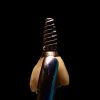
AsianScientist (Apr. 23, 2025) – A growing geriatric population, greater awareness of oral hygiene, rising income levels, and longer life expectancy have made Asia Pacific one of the largest markets for dental implants. However, this rise is marked by the growing prevalence of Peri-Implantitis (PI), a chronic inflammatory condition affecting the soft and hard gum tissues around dental implants.
The current treatment for PI is similar to that of periodontitis, also a chronic inflammatory gum disease, but underlying differences in the mechanism of these conditions remain unknown.
In a study, researchers at Pusan National University, South Korea, discovered a unique link between PI and activated fibroblasts. They also identified specific marker genes that may improve diagnosis and treatment. The study was published in the Journal of Dentistry.
As with natural teeth, bacteria can build up below the gum line at the base of an implant. Over time, this can cause inflammation and tissue damage. If left untreated, it can lead to bone loss under the implant, making the condition difficult to manage and prone to recurrence. It can even lead to implant failure.
For the study, researchers collected gum tissue from ten people with both conditions— Peri-Implantitis and periodontitis. They extracted RNA and used sequencing and bioinformatics to examine gene activity, immune responses, and tissue changes.
The study found that activated fibroblasts, cells in the connective tissue that have started to proliferate abnormally, may play a key role in peri-implantitis. The study also identified three specific marker genes that were more active in peri-implantitis, suggesting they could serve as specific biomarkers for the disease.
“This study provides essential insights into the role of activated fibroblasts as a distinctive factor in the pathogenesis of peri-implantitis versus periodontitis. Although peri-implantitis and periodontitis share clinical similarities, they exhibit distinct biological pathways. This research identifies three key biomarkers—ACTA2, FAP, and PDGFRβ—that are markedly overexpressed in peri-implantitis. These biomarkers have the potential to facilitate differential diagnosis and contribute to the development of peri-implantitis-specific therapeutic approaches,” said Yun Hak Kim, associate professor at Pusan National University’s School of Medicine and lead researcher.
Biomarker-based diagnostics could reduce misdiagnosis between PI and periodontitis, improve patient outcomes, and allow for more targeted treatments, especially for high-risk individuals.
“These findings could drive significant advancements in clinical strategies for diagnosing and treating peri-implantitis,” added Kim.
The differentially expressed genes identified in the study may guide the development of treatments tailored to PI’s distinct biology.
“Over the next 5-10 years, this study’s findings could serve as a fundamental basis for the development of highly specialized, targeted therapies addressing peri-implantitis, specifically focusing on its unique biological and immunological characteristics compared to periodontitis,” said Kim.
—
Source: Pusan National University; Image: Shutterstock
The article can be found at: Paired transcriptional analysis of periodontitis and peri-implantitis within same host: A pilot study
Disclaimer: This article does not necessarily reflect the views of AsianScientist or its staff.

